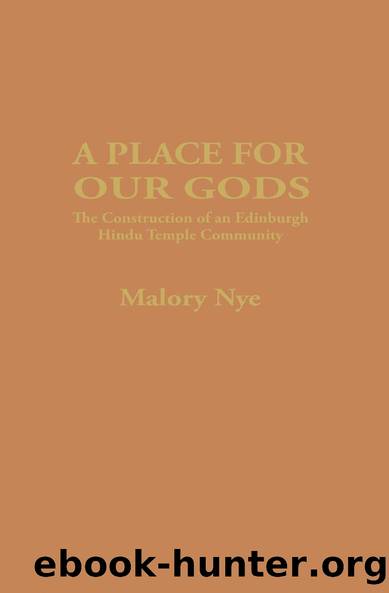A Place for Our Gods by Malory Nye

Author:Malory Nye [Nye, Malory]
Language: eng
Format: epub
ISBN: 9780700703562
Barnesnoble:
Publisher: Taylor & Francis
Published: 1995-11-16T00:00:00+00:00
Chapter Six
DEVOTIONAL WORSHIPâBHAJANS AND SATSANGS
6.1 Devotional bhajans
The format of worship at the temple is the result of a great deal of negotiation and bargaining. There is no obvious reason why the patterns of worship described above should have been chosen rather than any other forms. It is, therefore, worth asking why worship at the Edinburgh temple takes the forms that it does, and what is the significance of the various components. The singing of bhajans in particular is a very common form of worship among Hindus in Britainâthere are many references to this type of devotional worship in the literature on British Hinduism. Bhajan singing is described in Leeds, Bradford, London, Bristol, Coventry, Derby, and Leicester.1 In most of these cases the singing of bhajans is usually not the only form of worship performed at the temple.
It seems clear, however, that devotional worship is common among British Hindus and that a clear pattern is emerging, in which the singing of bhajans at satsangs is becoming established as an important form of congregational worship. Another common trend is the performance of hawan sacrificesâusually following the influence of Arya Samajis (c.f. §3.2.2). These are most often performed in temples, although OâKeefe (1980: 155) in East London describes how hawans can be organised in worshippersâ homes. This tendency for hawan has not become manifest in Edinburghâthe temple does own the fire grate (kund) for the ritual, but it is rarely used. I have heard a few individuals express a hope that the ritual will be instituted once a pandit arrives, but I do not think there is much overall desire for it. This is in contrast to the Glasgow Mandir, where hawan is performed at least once a month.2
The performance of satsangs in Edinburgh has developed into a form of temple worshipâit has become a tradition of activity which is firmly associated with temple life. I have already mentioned that this is not the case in other parts of BritainâMichaelson (1987:41-43) makes it clear that the performance of such satsangs in London are most usually associated with home worship and not temples. Even in Edinburgh, these satsangs are not always held in the templeâthey are often held in peopleâs homes. But despite these caveats, there is now a firmly established tradition in Edinburgh that bhajans should be sung whenever temple worship is organised.
The bhajans take up most of the satsang in terms of the time spent, and they are also the part of the worship which participants tend to devote most effort to. I would say that participants now particularly associate temple worship with bhajan singing. A small illustration of this is the remark made to me by an occasional worshipper at the temple. He commented that:
âat the temple all they do is just sing and playâ, (he illustrated this by making a gesture with his hands to show cymbals being clapped together).
This remark seemed to him to be an indictment of the Edinburgh temple.
This is what is done most at the temple, nearly all religious gatherings are marked by the singing of bhajans at some time or other.
Download
This site does not store any files on its server. We only index and link to content provided by other sites. Please contact the content providers to delete copyright contents if any and email us, we'll remove relevant links or contents immediately.
| Africa | Americas |
| Arctic & Antarctica | Asia |
| Australia & Oceania | Europe |
| Middle East | Russia |
| United States | World |
| Ancient Civilizations | Military |
| Historical Study & Educational Resources |
Cecilia; Or, Memoirs of an Heiress — Volume 1 by Fanny Burney(32063)
Cecilia; Or, Memoirs of an Heiress — Volume 3 by Fanny Burney(31458)
Cecilia; Or, Memoirs of an Heiress — Volume 2 by Fanny Burney(31409)
The Secret History by Donna Tartt(18168)
Sapiens: A Brief History of Humankind by Yuval Noah Harari(13993)
Leonardo da Vinci by Walter Isaacson(12805)
The Radium Girls by Kate Moore(11623)
Sapiens by Yuval Noah Harari(5125)
How Democracies Die by Steven Levitsky & Daniel Ziblatt(4964)
The Wind in My Hair by Masih Alinejad(4846)
Homo Deus: A Brief History of Tomorrow by Yuval Noah Harari(4691)
Endurance: Shackleton's Incredible Voyage by Alfred Lansing(4508)
Man's Search for Meaning by Viktor Frankl(4282)
The Silk Roads by Peter Frankopan(4275)
Millionaire: The Philanderer, Gambler, and Duelist Who Invented Modern Finance by Janet Gleeson(4105)
The Rape of Nanking by Iris Chang(4024)
Hitler in Los Angeles by Steven J. Ross(3800)
The Motorcycle Diaries by Ernesto Che Guevara(3788)
Joan of Arc by Mary Gordon(3786)
